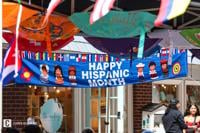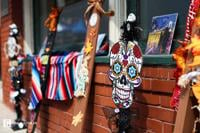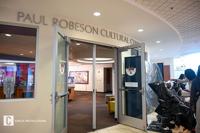At a predominantly white institution (PWI) where Hispanic students make up roughly 8% of the population, Penn State’s Hispanic and Latino community is determined to preserve culture and create a sense of home.
Hispanic students at the Penn State community come together during Hispanic Heritage Month, Sept. 15- Oct. 15, to celebrate the traditions, food and music through an array of events. This cultural showcase, organized by student organizations and faculty, is an effort to show students the many sides of Hispanic heritage and why it should be celebrated.
As vice president of communications for PSU’s Latino Caucus, Emily Sanchez said having a cultural identity at a PWI can come with some challenges, but is essential to maintain.
“My culture is part of my identity,” Sanchez, a fourth-year studying communication sciences and disorders, said.
Sanchez said she’s concerned with how new legislation regarding diversity, equity and inclusion (DEI) will possibly impact a PWI like Penn State that already struggles with representation.
“It’s important to find ways to work around things and not just completely stop the events that we’re known for,” she said. “I still want to keep the same events that we do, and give people the same sense of home, even though we have to change things around.”
Originally from Colombia, Sanchez joined the organization her freshman year and has been on the board of the club for three consecutive years, and credits Latino Caucus for giving her a community on campus and direction for her career goals post-graduation.
“I wish more Latino or Hispanic cultures were known to be able to be celebrated during Hispanic heritage month,” Sanchez said. “I think it’s also important to have more student engagement into those things, because that’s why these events are held.”
She encourages all kinds of students to participate more in the events and said that is one of the ways that Hispanic culture can thrive on campus.
A “Happy Hispanic Month” sign hangs above attendees at the Happy Valley Latin Festival on Saturday, Sept. 14, 2024 in State College, Pa.
A. K. Sandoval-Strausz, director of Latino/a studies, is confident that Hispanic students are capable of “preserving themselves” on campus.
“It’s a repetition of a very long tradition of immigrant groups, maintaining the things that were important to their parents and their grandparents,” Sandoval-Strausz said. “Whether it is in the form of music or food or religious observance, it’s just a thing that sort of makes people who they are, their ethnic identities.”
Hispanic students still may face difficulty in preserving a cultural identity at a PWI in comparison to other institutions, according to Sandoval-Strausz.
“The responsibility falls to smaller groups of people so they don’t have quite as big, let’s say, (a) likely constituency of people who are gonna celebrate with them,” Sandoval-Strausz said.
He expects Penn State’s population of Hispanic and Latinos to grow in upcoming years as they are largely contributing to population and economic growth in Pennsylvania.
“I hope (Hispanics) will feel more a part of the accepted mainstream of American society,” Sandoval-Strausz said. “That they won’t want to feel politically scapegoated or lied about as they often are today.”
He said he’s concerned about how stereotypes and “accusations” will impact the future of the Hispanic population, specifically Hispanic students, but is hopeful that future generations of students will feel accepted.
“It’s important to sort of imagine a future where we are not widely misunderstood,” Sandoval- Strausz said. “I think that’ll be a major goal to make sure that people understand who we are and all the things that the United States depends on us for.”
President of the Puerto Rican Student Association (PRSA), Larimar Rodriguez is committed to representing her culture and maintaining a “safe” community.
“A lot of the kids growing up around here or that live in different areas around here don’t really have the exposure to Hispanic communities as we do,” Rodriguez, a fourth-year studying biomedical engineering, said.
Rodriguez said to preserve Hispanic communities, it’s essential that students embrace each other and are dedicated to learning more about one another.

Day of the Dead skulls sit on a wall during the Happy Valley Latin Festival on Saturday, Sept. 14, 2024 in State College, Pa.
Within her own club, Rodriguez is determined to make anyone who wants to join feel welcome. She said her meetings are both in Spanish and English, so that anyone can understand and contribute.
“Making sure that everybody that’s part of your club remembers that they have a home,” Rodriguez said. “We have a little family on campus, it reminds us of where we came from.”
On campus, she hopes to see a bigger variety of Hispanic food in the dining halls, and a bigger display of Hispanic artists in the HUB-Robeson Center.
Mary Mendoza, an assistant professor of history, teaches about the U.S.-Mexico borderlands and the history of race relations and she said it’s important now more than ever to teach about Hispanic culture and its impact.
“It gets sort of erased from the national narrative in many respects,” Mendoza said. “Latinos are both systematically excluded from being full citizens of the United States, but also how the historical narrative and the way that we talk about it perpetuates some of these ideas.”
As a Mexican American, Mendoza advocates for a variety of perspectives in classrooms so students can learn more from their peers.
“Everybody’s voice is valuable,” Mendoza said.
She hopes multiculturalism continues to be celebrated throughout the year instead of having designated months.
Eduardo Mendieta, a retired professor of philosophy and a faculty member of Latino/a studies, wished Penn State “would do more.”
“We’re a public institution and we are supposed to serve the public and compared to other states we don’t have a lot of Hispanics,” he said.
Mendieta, who was born in Colombia, but grew up in New Jersey, thinks the university should place more effort in engaging students to participate in events and creating a deeper sense of community.
“Hispanic students want to blend in, and on the other hand they want to retain their identity,” Mendieta.
MORE NEWS CONTENT

The perpetuation of negative stereotypes about Hispanic people remains a challenge on colleg…





